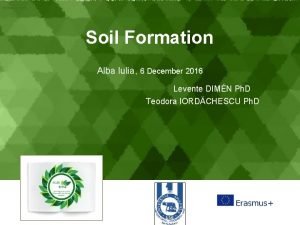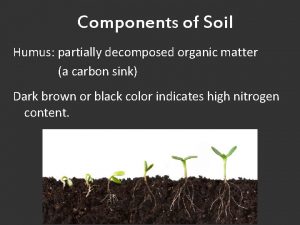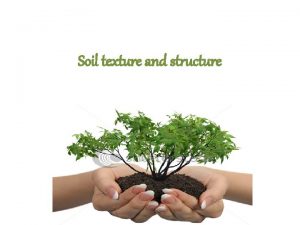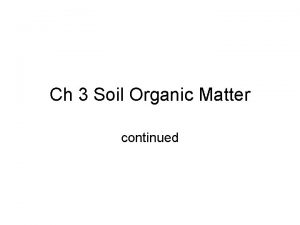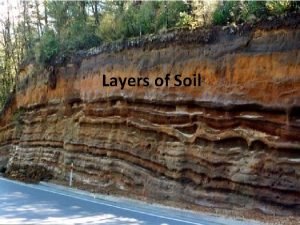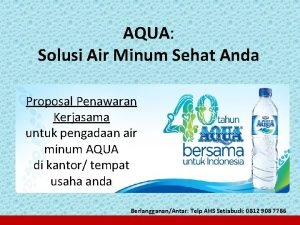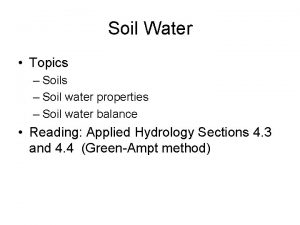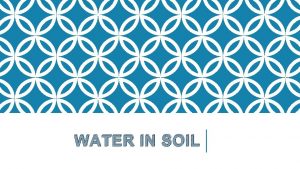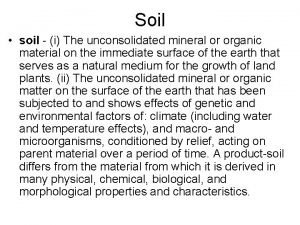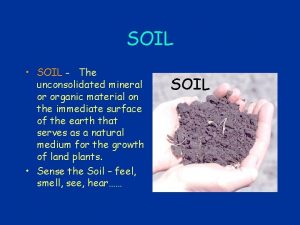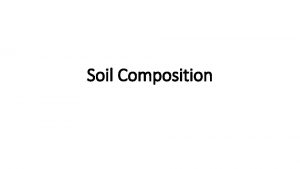Soil Components Mineral Particles Water Air Organic Particles










- Slides: 10

Soil Components: Mineral Particles Water Air Organic Particles Organisms 1 acre-foot of soil may contain 3 tons of organisms! Mineral Particles - We will ignore boulders, rocks, stones and pebbles air water nutrient size drainage capacity sand 1 -0. 1 mm +++ - - silt 0. 1 -0. 001 + ++ + + - - +++ clay < 0. 001 None of these single particles is ideal for growing plants Loam: a mixture suitable for growing plants

How Do We Know If We Have Loam? Surface Active Agent Surfactant clay Calgon Water mix, let settle 20% silt 40% sand 40% Perfect Loam Not all loams are “perfect”

Let’s Try Another Example Sandy Clay Loam clay 30% silt 20% sand 50% Supports Plant Growth ( NOT ON VIP! )

Let’s Try A More-Challenging Example ( NOT ON VIP ) Clay Loam clay 32% silt 35% sand 33% Supports Plant Growth You cannot draw ON the lines, but you MUST stay parallel to them!

Do You Really Understand This? ( NOT ON VIP ) If so, then you should be able to work this process backwards just as easily as forwards! You cannot Try to determine the draw ON the percentages of sand, silt, lines, but you and clay for the dot of the i MUST stay in silt loam. parallel to clay 13% them! silt 63% sand 24% 100% How do you check your work?

Macronutrients C CO 2 H H 2 O C. Hopkins Café: Mighty Good O P K N S limited in most soils the three parts of normal fertilizer Ca Fe Mg limited in CT soils due to acid rain… dolomitic limestone Fertilizer Guaranteed Analysis: N-P-K Example Analysis: 5 -10 -15 Balanced Fertilizer: Good for flower garden %phosphorus = 10% %potassium = 15% %nitrogen = 5% Another Example: 25 -0 -0 %phosphorus = 0% %potassium = 0% Single Fertilizer: Nitrogen good for lawn %nitrogen = 25%

Micronutrients Co • • • Mn Cu Come on cousin, see Mo by Al and Cleo Zn Si Mo B Al Cl Micronutrients are just as important but are needed in smaller amount These metal ions serve as cofactors for many enzymes Leached out of soils by acid rain Added to some blended fertilizers Recommended for Connecticut Nutrients Available to Plants Via Soil Water dissociates: H 2 O H+ + OH- [H+] = 10 -7 M p. H 7 [H+]: 100 10 -7 10 -14 p. H Scale: 0 7 14 neutral alkaline Pioneer farmers acid sweet bitter tasted the soil to sour vinegar d. H 2 O soap decide where to cranberry bean grass homestead

Cation Exchange - how plants “mine” soils clay particle opposite charges attract Ca 2+ Root Ca 2+ Mg 2+ Mo 2+ Zn+ Ca 2+ Cu 2+ Mg 2+ 2+ Ca H Ca 2+ Fe 3+ Ca 2+ hydrogen cation H secreted H Ca 2+ root hair Ca 2+ metal cations move up xylem + H+ + Ca 2+ hydrogen cation replaces metal cation + released metal cation available for root uptake

Cation Exchange - how acid rain depletes soil + + SO 2 NY: SO 2 + H 2 O -> H 2 SO -> 2 H 3 3 H + H+ H+ H+ + + H+ H H H+ + H+H + H+ H 2+ CT soil is left without metal cations! Fertilizers with micronutrients are needed. Ca Ca Mg Ca Cu hydrogen Mg Mo cations Mg Mo. Ca. Cu Mg Cu Mo Mg replace the Zn Mg Mg Ca Cu Zn Fe Ca metal Ca roots have Zn Fe Mo 2+ Mg 3+ Ca Mg cations Cu + 2+ nothing left to Fe 2+ Zn Mo Ca 2+ Ca Mg 2+ mine! 3+ 2+ +Fe released metal 2+ Zn. Mg Cu 2+ 2+ Ca Mo 3+ cations wash Fe. Ca 2+ Mg 2+ into root hair + 2+streams, Zn. Mg 2+ 2+ Cu Ca rivers, and Long 3+ 2+ Fe. Mo Ca 2+ Mg 2+ Island Sound + 2+ Zn. Mg NY: NO 2 + H 2 O -> H 2 NO 3 -> 2 H+ + NO 32 - -> CT acid rain! 2+ 2+ Cu Root H+ + H H+ H+ + + 2+ H H+ H + + + H H 2+ H+ H+2+ H + + H H + + + 2+ H H 2+ 2+ H+ + + 2+ 2+ H H 2+ 2+ 2+ H+ H+ H+ + + 2+H 2+ H+ H+ + H 2+ 2+ H+ 2+2+ + H+ 2+ + 3+H+ + H 3+ 2+ 2+ 2+

Soil Horizons A black Leaching zone: roots here (topsoil) B “red” Accumulating zone: nutrients (subsoil) C rocky Weathered bedrock D solid Bedrock Black color is caused by organic particles Horizons subject to erosion Prevented by: Rotting material makes humus particles • Mulching • Improve drainage (air capacity) • Proper cultivation • Increase water holding capacity • Perennial planting • Increase nutrient holding capacity leaves, grass clippings, compost, green manure, horse manure
